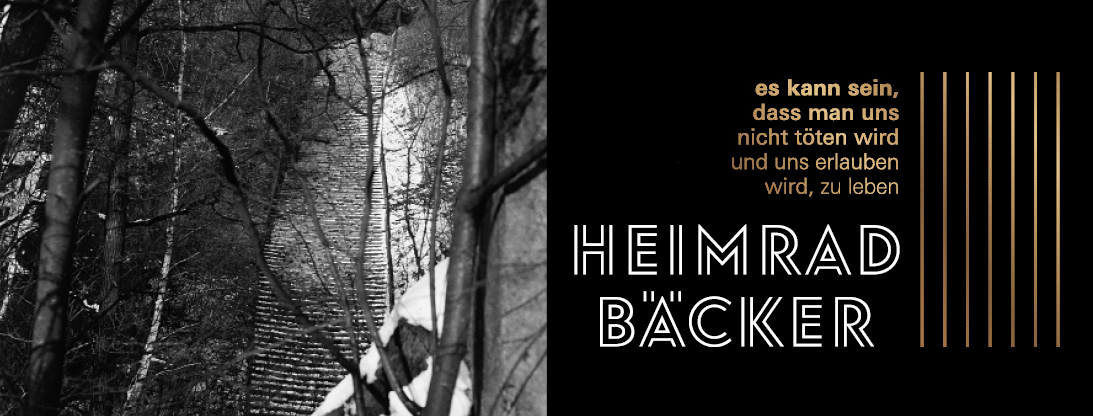The new exhibition of the Munich Documentation Center for the History of National Socialism Heimrad Bäcker: it is possible that they won’t kill us and they might allow us to live* is dedicated to the photographic legacy of Heimrad Bäcker. In 2015 a collection of more than 14,000 photographs, negatives, found objects, notes, and text-based works was bequeathed by Michael Merighi to mumok – the Museum of Modern Art Stiftung Ludwig Vienna. For the exhibition at the Munich Documentation Center a small selection of these photographs was displayed in groups arranged according to topic.
Heimrad Bäcker (1925–2003) was a writer and publisher and an important representative of the trendsetting Concrete Poetry of the Austrian literary avantgarde after 1945. He joined the Nazi Party at the age of eighteen, but was unable to perform active military serve because of illness. After the war, he studied philosophy, sociology, and anthropology.
Bäcker’s work as an artist is based on a decades-long preoccupation with National Socialism and on a critical reflection on his youth in the Nazi regime. He developed a text method that can be regarded as a “work of discovery of the genesis and structure of the Holocaust” and as a quest to raise awareness of Nazi crimes. Both for his project nachschrift (postscript), from which an excerpt spoken by Bäcker himself can be heard in the exhibition, and for his text installation die übrigen (those who remain) Bäcker used quotations from historical documents. For die übrigen Bäcker drew on texts from the Kalendarium der Ereignisse im Konzentrationslager Auschwitz-Birkenau von 1939 bis 1945 (Calendar of Events in Auschwitz-Birkenau Concentration Camp from 1939 to 1945), which he assembled as a se-ries. He employed a similar method for his photographic enquiry at the sites of the Mauthausen and Gusen concentration camps in Upper Austria, in addition collecting found objects—fragments of metal, wood, and concrete.
His visual documents, based on numerous visits to the former camps, trace the gradual changes that have taken place there. They depict the places where the prisoners worked and the barracks where they lived, but also the memorial. He found that large parts of the former camps had been allowed to decay or else had been used for other purposes. Bäcker’s work raises questions about remem-brance, preservation, and disappearance. In many cases there are several photos of the same motif, several phases of editing and forms of development as well as different modes of presentation. Unlike nachschrift, for which Bäcker researched and documented his sources very precisely, these photos are neither dated nor is their location specified. Shortly before his death, he had begun developing ideas for a book of photos which he gave the working title Landschaft M. The project remained unfinished.
In collaboration with the Mauthausen Memorial an interactive map was created on which visitors can locate some of the photos in the exhibition on the site of the former concentration camp and its surroundings.
Heimrad Bäcker’s work is juxtaposed with two works by contemporary artists. In the 2015 film Ein mörderischer Lärm (A Hellish Noise) by Tatiana Lecomte, the contemporary witness Jean-Jacques Boijentin describes with the help of the professional noise-maker Julien Baissat the unbearable noise in the tunnels of Gusen concentration camp where the prisoners had to work. Rainer Iglar‘s 1983 photo series Mauthausen 1974, which he took as a twelve-year-old on a school trip to the former concentration camp and rediscovered as an adult, shows the encounter between the photographer’s personal history and the history of the site. “The place is marked, it is not an innocent place,” says Iglar.
The exhibition will be accompanied by the thirty-minute documentary Heimrad Bäcker made by Isabelle Lagemann in 2002 for the Landesgalerie Oberösterreich.
* Quoted from Heimrad Bäcker, nachschrift 2, edition neue texte, Graz 1997, ed. Friedrich Achleitner and Thomas Eder, p. 5. Here Bäcker cites an entry by an un-known author in a diary from the Łódź ghetto, dated July 25, 1944, after: “Unser einziger Weg ist Arbeit,” Das Getto Łódź 1940–1944, Frankfurt / Vienna 1990, p. 268. Bäcker’s estate conserved at mumok includes a tablet on which this sentence is inscribed. It can likewise be seen in the exhibition.


